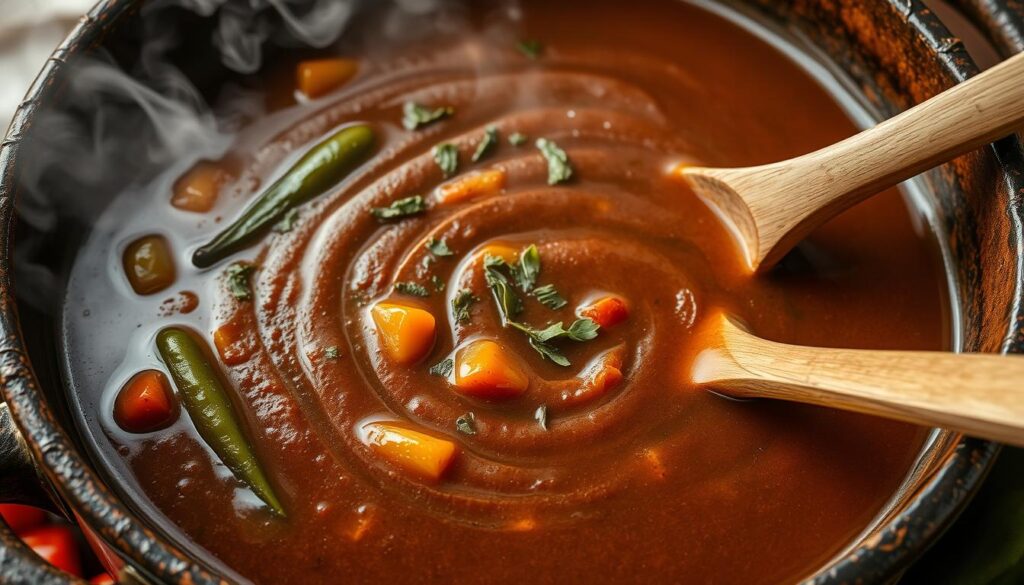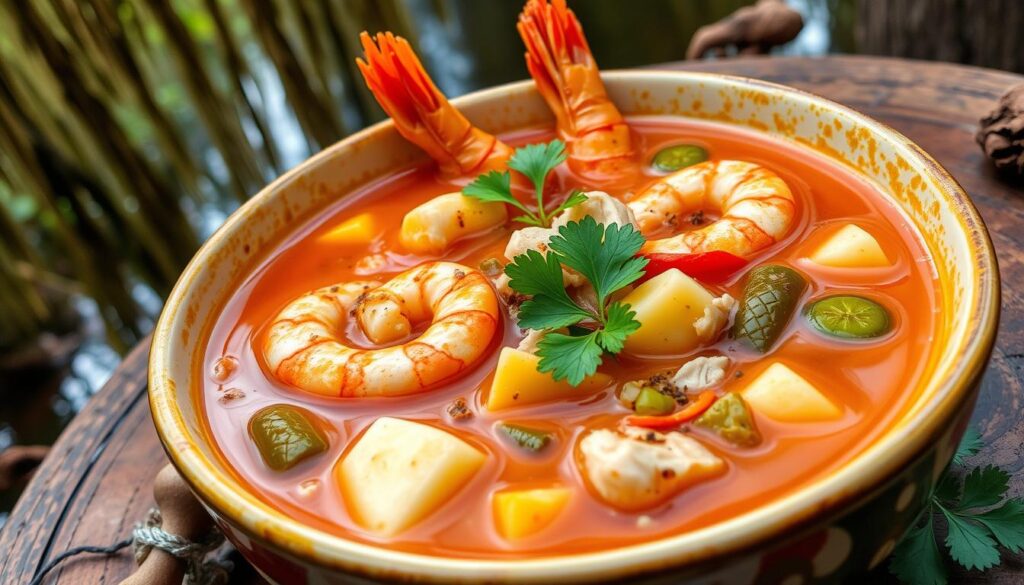Table of Contents
Imagine being in Louisiana, surrounded by the rich tastes of Cajun soup. This is a true staple of Louisiana cuisine. When you first taste swamp soup, you’ll feel like you’re in the bayous and swamplands of this lively state. Its special mix of spices and ingredients makes it a must-try for anyone wanting to taste the South.
Exploring swamp soup, you’ll learn about its rich history and cultural importance. It shows the diverse heritage of Louisiana. Whether you love spicy Cajun soup or hearty Louisiana dishes, swamp soup will quickly become a favorite.
Key Takeaways
- You will learn about the history and cultural significance of swamp soup
- Discover the unique ingredients and spices that make swamp soup a staple of Louisiana cuisine
- Explore the different variations of Cajun soup and their origins
- Get tips on how to cook authentic swamp soup at home
- Understand the importance of using high-quality ingredients in swamp soup
- Learn about the health benefits and nutritional value of swamp soup
The Rich History of Louisiana’s Swamp Soup
Exploring Louisiana cuisine, you’ll find bayou-inspired soup is a key part of Southern comfort food. Its history is as deep as its flavors, rooted in Cajun culture. The evolution of swamp soup shows the creativity and resourcefulness of its creators.
This dish holds deep cultural value in the bayou region. It symbolizes community and hospitality, often served at celebrations. Ingredients like andouille sausage and crawfish give the soup its unique taste. Learning about swamp soup’s history teaches us about the importance of keeping traditional cooking alive.
Origins in Cajun Culture
Cajun culture is known for its lively music, colorful festivals, and tasty food. Swamp soup’s origins go back to early Cajun settlers, who made a flavorful stew with what they had. The recipe has grown, adding new ingredients and techniques while staying true to its Cajun roots.
Evolution Through Generations
Over time, swamp soup has changed, with each family adding their own touch. It became a big part of Louisiana cuisine, loved across the Southern United States. Now, you can find different versions of swamp soup everywhere, each with its own special taste.
Cultural Significance in the Bayou
Swamp soup’s cultural importance in the bayou is clear. It brings people together, creating a sense of community. Learning about swamp soup’s history and cultural value helps us appreciate the importance of keeping traditional cooking alive.
| Ingredient | Traditional Use |
|---|---|
| Andouille Sausage | Adds a smoky flavor to the soup |
| Crawfish | Provides a rich source of protein and flavor |
| Okra | Thickens the soup and adds texture |
What Makes Swamp Soup Unique
Swamp soup is a hearty stew unlike any other. It combines a dark roux soup base, rich spices, and various ingredients for a unique taste. The dark roux base gives it a depth of flavor that’s unmatched.
The secret to a great swamp soup lies in its balanced ingredients. It includes meats, seafood, and vegetables. This mix, along with the dark roux base, makes it a standout in Louisiana cuisine. Dark roux is a slow-cooked flour and fat mix that thickens the soup.
What makes swamp soup unique includes:
- A rich, dark roux base that’s cooked to perfection
- A blend of spices and seasonings that add depth and complexity to the dish
- A variety of ingredients, including meats, seafood, and vegetables, that come together to create a hearty stew
Swamp soup offers a perfect mix of flavors and textures. The dark roux base makes it thick and velvety. The mix of ingredients adds a burst of flavor in every spoonful. It’s perfect for those who crave comfort or something new.
| Ingredient | Quantity |
|---|---|
| Dark roux | 2 tablespoons |
| Meat and seafood | 1 pound |
| Vegetables | 2 cups |
Essential Ingredients for Authentic Swamp Soup
To make a real Cajun soup, focus on key ingredients. These make this Louisiana cuisine dish special. The base vegetables and aromatics give it depth and flavor.
For a great swamp soup, consider these essential ingredients:
- Onions and garlic for added flavor
- Celery for a fresh, herbal note
- Mushrooms for earthy undertones
The meat and seafood you pick also matter a lot. Traditional choices are andouille sausage, chicken, shrimp, and crab. These, with Louisiana cuisine seasonings and spices, make swamp soup unique.
Common seasonings in swamp soup are paprika, thyme, and cayenne pepper. Mixing these right lets you make a tasty, true swamp soup. It highlights the best of Louisiana cuisine.
| Ingredient | Quantity | Preparation |
|---|---|---|
| Onions | 2 medium | Chopped |
| Garlic | 3 cloves | Minced |
| Celery | 2 stalks | Chopped |
Mastering the Dark Roux Base
To make a rich and flavorful dark roux soup, mastering the dark roux base is key. This is a critical part of swamp soup. It needs patience and practice to get it right. A dark roux is what makes swamp soup special, setting it apart from other soups.
For a dark roux, the right ingredients and techniques are crucial. You’ll mix flour and fat, like oil or butter, in a certain ratio. The goal is to cook it slowly over low heat, stirring constantly, until it’s deep brown. This can take up to 30 minutes, but it’s worth it.
Here are some tips to help you master the dark roux base:
- Use a heavy-bottomed pot to prevent the roux from burning or sticking.
- Stir the roux constantly to ensure even cooking.
- Don’t be afraid to experiment with different types of flour and fat to find the combination that works best for you.
With practice, you’ll become a master of the dark roux. Your swamp soup will impress everyone who tries it. Remember, patience and attention to detail are key. Take your time and try new things – it’s all part of making a delicious stew.

Step-by-Step Cooking Method
To make a real Southern comfort food like swamp soup, follow a step-by-step guide. This bayou-inspired soup is a key part of Louisiana’s food scene. Its rich taste comes from careful preparation and attention to detail. Remember, the secret to a great swamp soup is the layers of flavor you build while cooking.
Begin by getting your ingredients ready. These usually include meats, seafood, vegetables, and spices. The quality of your ingredients greatly affects the soup’s flavor. So, pick the freshest options you can find. Once you have everything ready, start making the base flavors of your soup.
Preparing Your Ingredients
This first step is very important. It sets the stage for the rest of the cooking. Take your time to chop, dice, and slice your ingredients. Make sure they’re all ready before you start cooking.
Building the Base Flavors
With your ingredients ready, start building the base flavors of your swamp soup. First, sauté your aromatics. Then, add in your meats and seafood. Your goal is to create a rich, deep flavor that will be the foundation of your soup.
Simmering and Seasoning Tips
After building your base flavors, let your swamp soup simmer. This slow cooking lets all the flavors mix together, making a delicious Southern comfort food. As you simmer, season your soup regularly. This is when you add your traditional seasonings and spices, giving it that authentic bayou flavor.
By following these steps and tips, you’ll make a delicious and authentic swamp soup. It’s sure to be a hit with your friends and family. So, go ahead and try it out. Experience the rich flavors of this beloved Southern comfort food for yourself.
| Ingredient | Quantity |
|---|---|
| Meat and Seafood | 1 pound |
| Vegetables | 2 cups |
| Spices and Seasonings | 1 teaspoon |
Regional Variations Across the South
Exploring Louisiana cuisine reveals that swamp soup varies by region. Each area in the South adds its own twist to this Cajun soup. From Texas’s spicy flavors to the Gulf Coast’s seafood, every region has its own special flavor.
Some notable variations include:
- The Texas-style swamp soup, which often features beef or chicken and a blend of spices for an added kick
- The Gulf Coast version, which showcases an abundance of fresh seafood, such as shrimp, crab, and oysters
- The traditional Louisiana cuisine take, which emphasizes the importance of a rich, dark roux and a medley of vegetables and meats
Exploring these regional variations shows the diversity and richness of swamp soup. Whether you love spicy flavors or seafood, there’s a version for you. So, why not start a culinary journey and explore the unique flavors of Louisiana cuisine and swamp soup across the South?
Essential Equipment and Tools
To make a tasty swamp soup, you need the right tools. This Southern dish needs special gear to enhance its flavors. The pot you choose is crucial for cooking a hearty stew.
A large, heavy-bottomed pot is best for swamp soup. It ensures even heat and prevents burning. You can pick from stainless steel, cast iron, or enamel-coated cast iron pots. Each has its own benefits and drawbacks, so choose based on your cooking style.
Pot Selection Guide
- Stainless steel pots are durable and easy to clean, but may not retain heat as well as other materials.
- Cast iron pots are excellent heat conductors, but can be heavy and require seasoning.
- Enamel-coated cast iron pots offer the benefits of cast iron with a non-stick surface, but may be more expensive.
You’ll also need some key utensils for swamp soup. These include a large spoon, a whisk, and a spatula. A large spoon helps stir and scoop. A whisk is great for mixing the dark roux soup. A spatula is useful for scraping the pot and mixing ingredients.
Must-Have Utensils
| Utensil | Description |
|---|---|
| Large spoon | Stirring and scooping |
| Whisk | Mixing and blending |
| Spatula | Scraping and folding |
With the right tools, you’re ready to make a delicious swamp soup. It will become a favorite in your home.
Perfect Pairings and Side Dishes
Enjoying a delicious bowl of bayou-inspired soup is even better with the right pairings and side dishes. For a traditional Cajun soup, try it with crusty bread or spicy cornbread. The bread’s crunchy texture and sweet flavor match the soup’s rich, savory taste.
Other great side dishes for Louisiana cuisine include hushpuppies, fried okra, and a simple green salad. These add a nice contrast in texture and flavor. You can also add remoulade sauce or a sprinkle of filé powder for extra flavor.
Here are some ideas for perfect pairings and side dishes for your bayou-inspired soup:
- Crusty bread with a side of spicy cornbread
- Hushpuppies with a remoulade sauce
- Fried okra with a side of green salad
- Grilled shrimp with a sprinkle of filé powder
Exploring these pairings and side dishes can make a unique and delicious meal. Whether you prefer something classic or adventurous, there’s a perfect pairing for your Cajun soup.

Storage and Reheating Guidelines
Enjoying your swamp soup, a true Southern comfort food, means keeping it fresh and tasty. Proper storage and reheating are key. Follow these tips to enjoy your swamp soup for days, keeping its rich flavor intact.
First, cool your swamp soup to room temperature before refrigerating or freezing. This step stops bacterial growth and keeps your dish quality high. For the fridge, use airtight containers and eat within three to five days. Freezing? Portion it into smaller containers or bags for easy reheating.
Freezing Instructions
Freezing is great for keeping your swamp soup longer. Label your containers with date and contents when freezing. Frozen soup stays good for up to three months. To reheat, thaw overnight in the fridge and then heat on the stovetop or in the microwave.
Maintaining Flavor Quality
To keep your swamp soup’s flavor, reheat it gently. Overheating can dull the taste. Reheat over low heat, stirring now and then, until it’s warm. If it’s too thick, add a bit of water or broth.
By sticking to these storage and reheating tips, you can enjoy your swamp soup longer. It’s a true Southern comfort food, with its hearty stew flavor preserved.
| Storage Method | Shelf Life | Reheating Instructions |
|---|---|---|
| Refrigeration | 3-5 days | Reheat on stovetop or in microwave |
| Freezing | Up to 3 months | Thaw overnight, reheat on stovetop or in microwave |
Troubleshooting Common Issues
When making dark roux soup, a staple of Louisiana cuisine, you may encounter some common issues. These can affect the flavor and texture of your dish. One common problem is a too-thick roux, making your soup overly dense and heavy.
To avoid this, just adjust the ratio of flour to fat in your roux. Also, make sure to cook it for the right amount of time. If your soup lacks flavor, try adding more aromatics like onions, bell peppers, and celery. These are key in Louisiana cuisine. You can also experiment with different seasonings and spices to find the perfect balance of flavors for your dark roux soup.
Some other common issues that may arise when making Cajun soup include:
- Insufficient acidity, which can be resolved by adding a splash of vinegar or lemon juice
- Overcooking, which can result in a tough, unappetizing texture
- Incorrect seasoning, which can be adjusted by tasting and adjusting as you go
By being aware of these potential issues and taking steps to prevent them, you can create a delicious and authentic dark roux soup. This showcases the best of Louisiana cuisine. With practice and patience, you’ll be able to troubleshoot common problems and develop the skills and confidence you need to make outstanding Cajun soup every time.
Health Benefits and Nutritional Information
Enjoying a warm bowl of swamp soup is not just tasty. It’s also good for you. This Southern comfort food is full of nutrients that help keep you healthy.
Swamp soup is rich in protein, which is key for muscle health. The mix of meats and seafood in the soup boosts your protein intake. Plus, the veggies and spices add minerals like iron, calcium, and potassium.
Protein and Mineral Content
Swamp soup is a nutrient powerhouse. It’s packed with:
- Protein: 25-30 grams per serving
- Iron: 10-15% of the daily recommended intake
- Calcium: 5-10% of the daily recommended intake
- Potassium: 10-15% of the daily recommended intake
Dietary Considerations
Swamp soup is good for you, but watch out for sodium. The broth and spices can make it high in salt. Use low-sodium broth and add salt sparingly to cut down on sodium.
Knowing what’s in swamp soup helps you enjoy it more. It’s a comforting meal that’s also healthy. So, whether you’re in the mood for something cozy or a nutritious meal, swamp soup is a great choice.
| Nutrient | Amount per serving |
|---|---|
| Calories | 250-300 |
| Protein | 25-30g |
| Fat | 10-15g |
| Carbohydrates | 20-25g |
Conclusion
Swamp soup is more than a tasty dish; it’s a key part of Louisiana cuisine and Cajun traditions. By learning to make this Cajun soup, you’ve grown to love its rich history and cultural value.
The story of swamp soup is about keeping traditions alive. It’s a journey through generations in the Louisiana bayou. Every pot of soup tells a story of the region’s spirit, where land and water meet to create a special meal.
When you enjoy swamp soup with loved ones or share it with others, you help celebrate Louisiana cuisine. You’re keeping alive the flavors and traditions of the bayou. Let the bayou’s scents and tastes inspire you to dive deeper into Cajun and Creole cooking.
FAQ
What is swamp soup?
Swamp soup is a rich stew from Louisiana’s bayou. It’s made with a dark roux, meats, seafood, and veggies. This mix creates a comforting dish loved in Cajun and Louisiana cuisine.
What are the key ingredients in swamp soup?
Swamp soup’s key ingredients are a dark roux, aromatic veggies, and a protein like shrimp or sausage. It’s seasoned with Cajun spices like cayenne and thyme.
How is the dark roux prepared for swamp soup?
The dark roux is the soup’s base. It’s made by cooking flour and fat slowly until it’s dark. This process takes about an hour, adding a rich flavor to the soup.
What are some of the regional variations of swamp soup?
Swamp soup varies across the South. In Louisiana, it might include andouille sausage or okra. Texas versions are spicier, while Gulf Coast soups focus on seafood.
How do you properly store and reheat swamp soup?
Store swamp soup in the fridge for 4 days or freeze it for months. Reheat it slowly, stirring often, to keep the roux smooth. Add broth if it’s too thick.
What are some of the health benefits of swamp soup?
Swamp soup is nutritious, packed with protein from meats and seafood. It also has minerals and vitamins from veggies and herbs. Just remember to eat it in moderation as part of a balanced diet.

